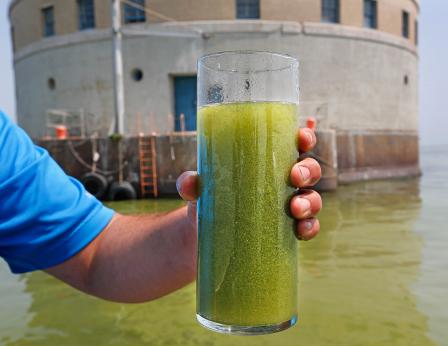Epidemiology & Health Effects of Cyanobacteria
 Cyanobacteria, or blue-green algae, occur worldwide often in calm, nutrient-rich waters. Some species of cyanobacteria produce toxins that affect animals and humans. People may be exposed to cyanobacterial toxins by drinking or bathing in contaminated water. The most frequent and serious health effects are caused by drinking water containing the toxins or by ingestion during recreational water contact like swimming. Cyanobacteria can also cause problems for drinking water treatment systems. EPA researchers are looking for ways to decrease the negative impacts of cyanobacteria.
Cyanobacteria, or blue-green algae, occur worldwide often in calm, nutrient-rich waters. Some species of cyanobacteria produce toxins that affect animals and humans. People may be exposed to cyanobacterial toxins by drinking or bathing in contaminated water. The most frequent and serious health effects are caused by drinking water containing the toxins or by ingestion during recreational water contact like swimming. Cyanobacteria can also cause problems for drinking water treatment systems. EPA researchers are looking for ways to decrease the negative impacts of cyanobacteria.
Drinking Water Treatment Safety Research
Algal blooms have caused problems in water treatment for decades – from blocking filters to causing odors in the water. To help keep our water safe, EPA researchers are looking at water quality data and phytoplankton samples to examine the impact of algal blooms on creating disinfection byproduct (DBP) precursors. DBP problems usually occur during summer months due to warmer water, and faster DBP formation. Summer months also correspond to the formation of algal blooms. This research is currently ongoing, but scientists are researching ways to keep our water safe.
Characterizing Cyanobacterial Toxins
Does exposure to cyanobacteria cause skin and allergic reactions? EPA researchers are looking at the effects of cyanobacterial toxins and their by-products and synergistic interactions to find out. Some studies have found a significant correlation between exposure to cyanotoxins and allergic reactions, especially in sensitized individuals. EPA researchers along with researchers at the Northern Kentucky University and the University of Cincinnati are working on a better assessment of the toxicological and allergic response potential from cyanobacteria.
Determining Toxigenic Properties
Toxin production in cyanobacteria is highly variable. Not all cyanobacterial species produce toxins and in some cases, a single species can produce a variety of toxins. Researchers are analyzing cyanobacteria, water quality parameters, and assays of microcystins – toxins produced by the cyanobacteria -- associated with environmental bloom samples from local urban watershed ponds.
Cyanobacteria, Nutrients, and Land Use
EPA researchers are looking for ways to manage nutrient loads in water and reduce cyanobacterial risks to human health and well-being by providing access to scientific knowledge and tools. The goal of this research is to advance the science and promote the sustainable stewardship of water resources for the maintenance of healthy communities, ecosystems, and economies for current and future generations.
Disease Outbreaks Related to Toxic Algal Blooms
Harmful algal blooms can produce biotoxins and adversely affect the health of people and animals as well as ecosystems. Blooms can create bad odors, they can discolor the water or accumulate as a scum on the surface of the water. People and animals should not recreate in or drink directly from lakes and ponds that have a scum on the water, and people should observe any local water advisories. EPA researchers work with the Centers for Disease Control and other organizations understand the impacts of blooms and to find ways to reduce their impact on people, animals, and the environment.
Publication: Algal Bloom-Associated Disease Outbreaks among Users of Freshwater Lakes – United States, 2009-2010
Detection and Enumeration of Potentially Toxic Cyanobacteria
This research employed an innovative approach to to adapt and validate a rapid and accurate optical fiber-based technology for the detection and enumeration of potentially toxic cyanobacteria. It was built from prior studies on marine harmful algal bloom species. This research successfully developed novel fiber-optic genosensors for the detection of cyanoHAB species, and also produced technology that is transferable to a wide range of probe-based assay systems and autonomous monitoring instrumentation to provide early warning of organisms that threaten public and ecosystem health.
Final Report: Development and Application of a Fiber Optic Array System for Detection and Enumeration of Potentially Toxic Cyanobacteria
